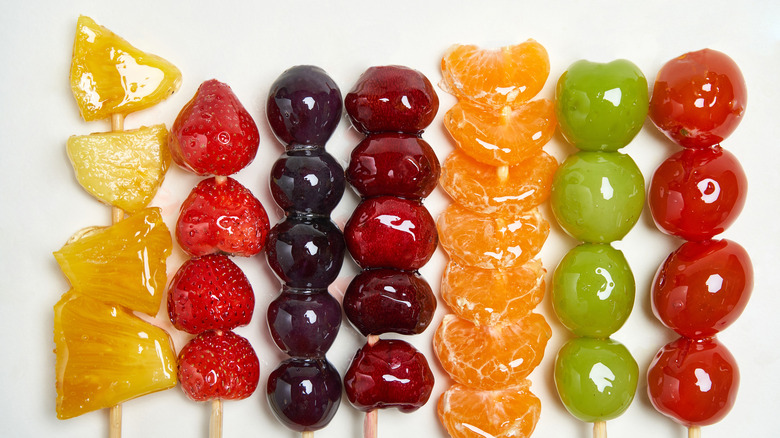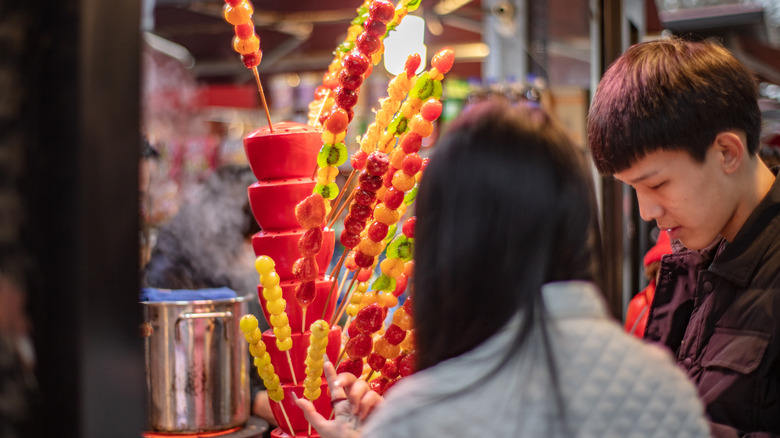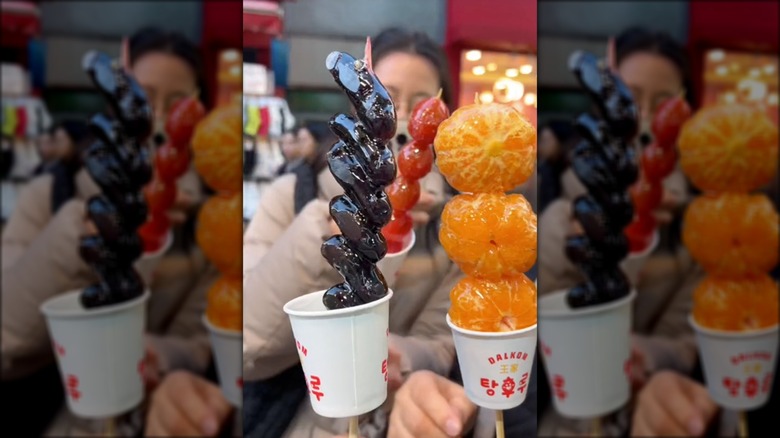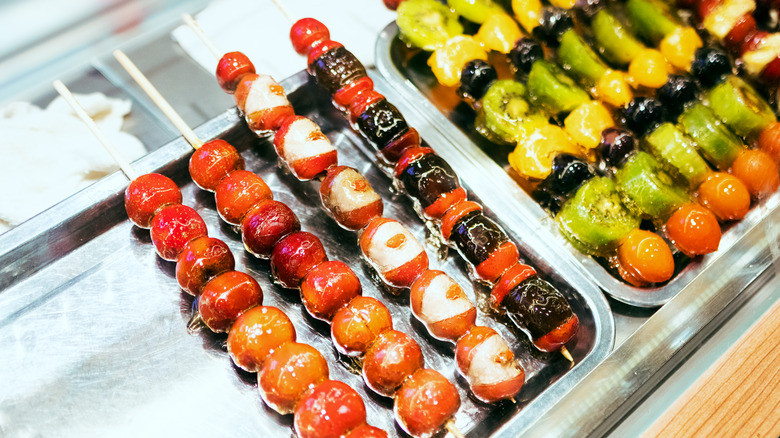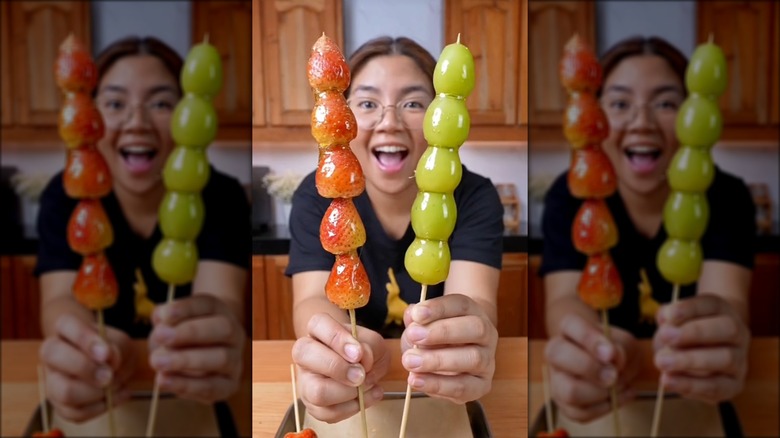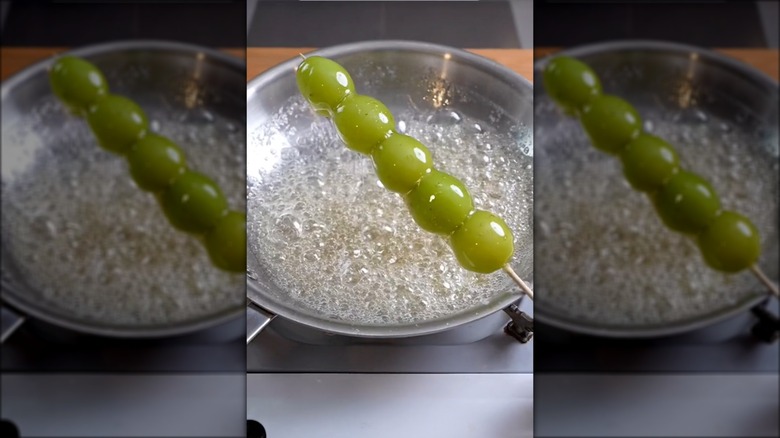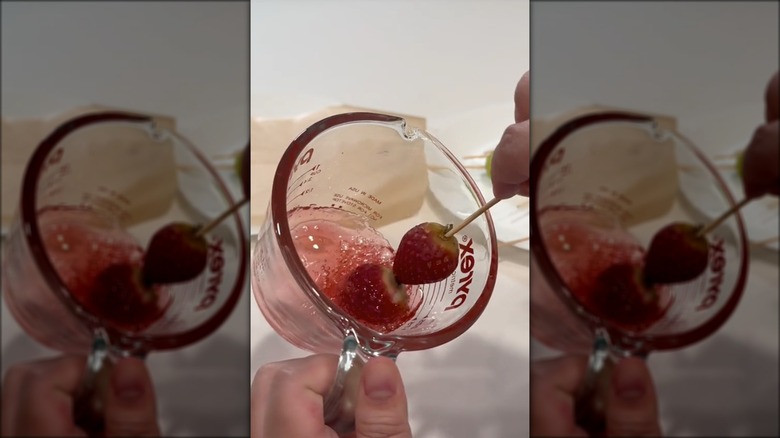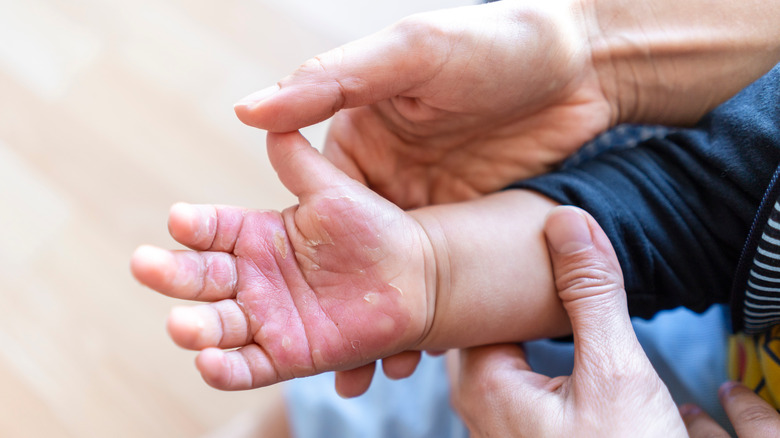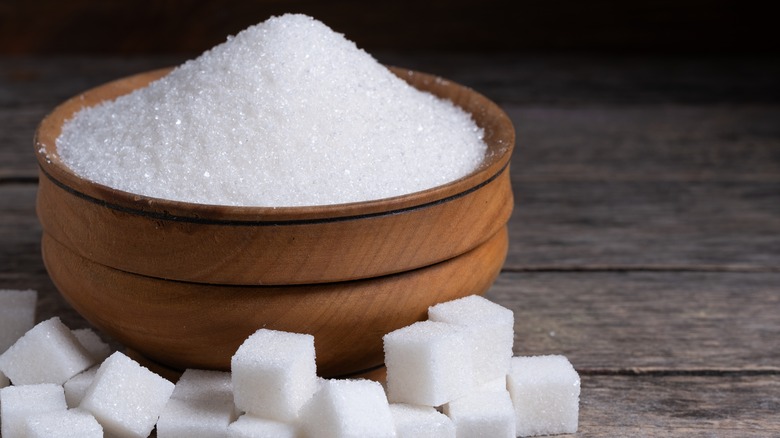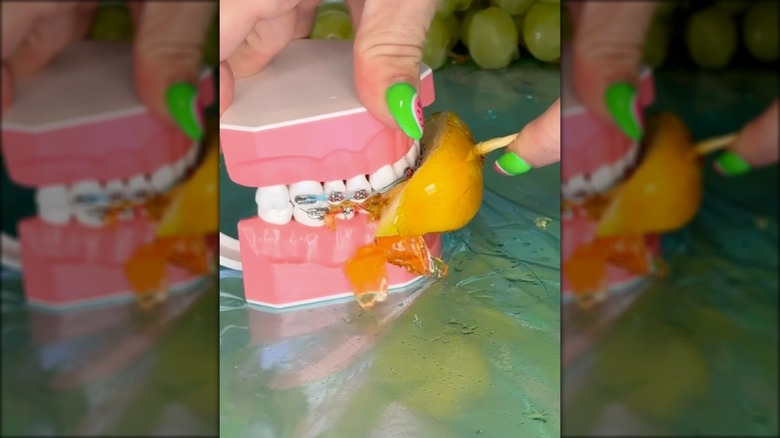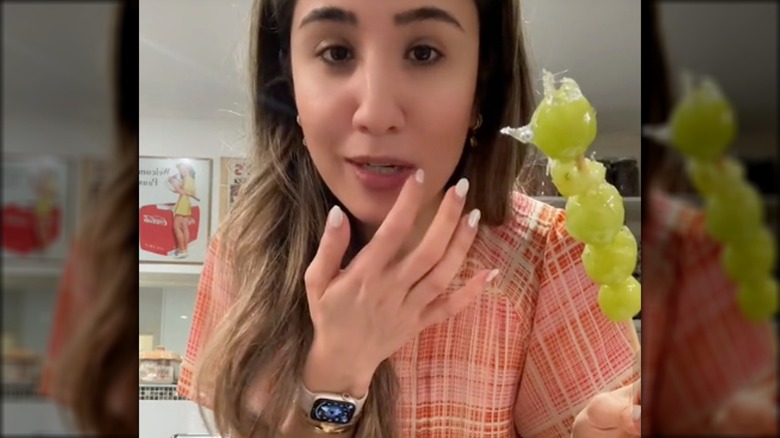Why You Shouldn't Try Making Tanghulu Candy At Home
Even if the social media images and videos of gorgeous tanghulu candy have been tempting you, we've gathered quite a few reasons why you shouldn't make it at home. Unfortunately, what starts out as a fun activity inspired by seemingly harmless videos has been sending people in the U.S. and around the world to seek medical help.
These fruit-filled candies have been around for centuries, but they've only become a worldwide sensation relatively recently. Even though it's not a new candy, the idea of making it at home has exploded across the internet and across the world. In countries like China and South Korea, you can buy them from street vendors or dedicated shops. However, the internet turning it into a viral snack for people to make at home has created a global issue of trips to emergency rooms and dentist offices. We've traced this candy from its origins to its current incarnations and uncovered what is making it so dangerous to eat and to make at home.
Tanghulu combines fruit and candy all at once
Tanghulu candy (also called bingtang hulu) is fresh fruit candy that originated in China. When you think of candied fruit, the one that probably comes to mind is caramel apples, but tanghulu is different. It starts with small pieces of fresh, ripe, ready-to-eat fruit skewered on a long wooden stick. Then, it's covered with a brittle, clear, and shiny candy shell.
Some purists feel that the only type of candied fruit that should be called tanghulu is candied hawthorn berries, which is what was in the original candy. Made with tart hawthorn berries, the original is a sweet and sour candy. However, as more and more people across the world have discovered this candy and made it their own, they have used whatever fruits they have at hand, like strawberries and grapes.
The simplest version of the candy is made by dipping fruit skewers into a mixture of boiling 300 degree Fahrenheit sugar and water. However, we've seen recipes that also called for different candy coating ingredients to improve visuals and flavor. While it will keep for up to 24 hours, eating it as quickly as possible after cooling provides the best crunch.
Tanghulu candy has deep historical roots in ancient China
Tanghulu came into favor at the Chinese royal court during the Song Dynasty (960 to 1279). The story goes that a doctor for the Emperor's beloved mistress prescribed hawthorn for her serious digestive ailments. However, he suggested cooking the tart berries with sugar to make them more palatable. After two weeks of eating these sugary fruits, it is said to have cured her maladies. Accounts vary concerning the name of the specific emperor and concubine. Regardless, the idea caught on as a curative snack idea for the royal family.
Hawthorn berries, have been a part of the Chinese traditional medicine tradition for centuries. As such, this candy was one part sweet treat and one part medicinal. The berries were used to help with digestion. However, they were also consumed to help with heart problems like high blood pressure. In the modern era, researchers have studied these potential benefits and more for hawthorn berries.
In modern-day China, you can still find this candy being sold from street food vendors for around a dollar. However, you're more likely to find it in the winter than in the summer because it holds up better in cool weather than hot. It's a common lucky food for Lunar New Year, available both on the streets and in temples.
It's also become a phenomenon in South Korea
In the 2010s, tanghulu became popular in South Korea — so much so that many people incorrectly assume that it's a South Korean candy. At first, you could mainly only find it being sold from street vendors in Incheon's Chinatown and a few touristy areas in Seoul. However, now, it's popular enough to have become available in dedicated tanghulu shops all over the country.
It's popular enough that some shops are selling as many as 200 of the candies each day. At the lower end, each skewer costs somewhere around $2.25 to $3, with higher-end ones costing closer to $5.25.
Wang Ga Tanghulu, which opened in 2017, was South Korea's first tanghulu franchise. Its experiments with making less sticky, more crisp candy shells helped it grow into the largest tanghulu franchise in the country. In the months between February and August 2023 alone, the Wang Ga Tanghulu increased from 50 to 350 locations.
There are lots of variations
While the original fruit for tanghulu is hawthorn, most places that serve it today use other fruits. Some common ones include strawberries, mandarin oranges, pineapple, a wide variety of grapes, cherries, and kiwi.
Some tanghulu shops like South Korea's Wang Ga Tanghulu have thought beyond ordinary fruit skewers to other ways to serve these candied fruits. For example, it serves patbingsu (a type of South Korean shaved ice) topped with frozen yogurt, fresh fruit, and crisp tanghulu for a contrast of textures and flavors. Some juice bars have even added tanghulu to their drinks. There are some more unusual ingredients that tanghulu makers sometimes sell in a candy shell, like cherry tomatoes and cucumbers, rice cakes, macarons, and a South Korean cookie called yakgwa. They've even been served inside macarons.
Having had more time for development, China can be even more daring with what it encloses in a bubble of clear candy. Some more interesting early Chinese tanghulu recipes include ones for mountain lilies, crabapples, and bean paste. At the tamer end of modern offerings, you might find nuts (including walnut-stuffed hawthorn berries), date plums, black jujubes, Chinese yams, and latiao (a spicy Chinese snack food).
Tanghulu has become a social media sensation
Making tanghulu at home started taking off during the COVID-19 pandemic when people were turning to social media for new recipes to try. ASMR (autonomous sensory meridian response) fans found the sound of biting into the shattering candy shells to be mesmerizing. Their bright colors and glassy exteriors also make them appealing for visually-oriented social media formats. When you do a TikTok search for tanghulu, the videos that pop up first mostly have millions or hundreds of millions of hits. On Instagram, it's more modest, but there are still thousands or hundreds of thousands of hits for many of the posts.
At the beginning of 2023, South Korean teens went gaga over the treat, searching more for tanghulu than for any other snack food they were curious about on social media. People have tagged over 130,000 separate items with tanghulu in the Korean language on Instagram alone. Even K-Pop stars Jisso and Jennie from Blackpink (who once teamed up with Oreo) have a YouTube video demonstrating how to make this snack at home.
Many of the earlier tanghulu videos and photos you'll find online come from China or South Korea. However, with the worldwide and viral nature of social media, it's become a phenomenon around the world, with people from a variety of cultural heritages giving it a try.
Making these candies at home comes with a scald burn risk
When making it at home, the sugar syrup for your tanghulu will be boiling at 300 to 350 degrees Fahrenheit when it's ready for dipping, which is well above the boiling point of water. So, you can imagine how incredibly painful it can be when it hits like molten lava on your skin or mouth. The damage can range from second- or third-degree burns, leaving long-term scarring, nerve damage, and burns that require physical therapy to recover from.
There are lots of ways you can end up burning yourself while making candy on a hot stove. However, with dipping fruit into molten hot sugar syrup and moving it to cool, there are so many more chances at burning yourself than with normal cooking.
Using the front burners of your stove to make it is especially dangerous for three reasons. First of all, it's been our experience that the front burners on electric stoves are often larger and quicker to heat up. So, it can start to boil and pop hot candy syrup all over you before you have time to respond. The front burners are also closer to your body, making the risk of having the hot liquid splash on you that much more likely. Another risk is that you're more likely to knock against the pot handle and splash scalding liquid on yourself with the pan on the front stove burner.
Microwave hacks for making tanghulu increase the risk of scalding
Many TikTokkers have started using the microwave instead of the stovetop for heating the sugar syrup for the candy. There are plenty of chances for scalding when using the microwave to make tanghulu. The risks start from the moment you grab hold of the super-hot bowl in the microwave and continue while testing the temperature, carrying it to the countertop, during the dipping process, or moving it to cool.
One of the hacks for making tanghulu involves melting Jolly Ranchers candy in the microwave rather than using sugar and water. Not only does it only take about a minute to melt the candy and make it boil, but it adds an extra layer of flavor to tanghulu. Some TikTokkers have gone a step further by coating their Jolly Rancher tanghulu or regular tanghulu in other ingredients like Pop Rocks, other small candies, or tajin. That extra step of rolling the candies in Pop Rocks while it's still hot increases the burn risk.
Dr. Colleen Ryan, a surgeon from Shriners Children's Boston says, "When sugar is melted in the microwave like this, it has a high heat capacity, meaning it stores the heat energy. If spilled, it can create a severe scald burn, much like spilling hot soup, but it can cause a much deeper burn because of sugar's properties." She explains that splatters or spills can cause "very deep burns, often in critical areas such as the hand or the face."
The trend is especially risky for younger candy makers
By some accounts, about a fourth of the people watching TikTok videos in the U.S. are children, and children don't always make the wisest choices when it comes to internet trends and cooking. Plus, they may not have developed the coordination yet to be safe in the kitchen, even under adult supervision.
When the microwave hack for making tanghulu showed up on social media, kids assumed it was something they could easily do with no stove required. Microwaving sugar or Jolly Rancher candy to boiling was the simple part. However, getting it out of the microwave (especially one mounted high up) without spilling or splashing it on their skin was a bigger challenge. The bowl and liquid sugar is hot. Plus, there's the added danger of being so eager to taste it that they might try it before it's cooled.
Shriners Children's hospital reports seeing lots of children and teens coming into their facility with severe burns related to making tanghulu. It's become enough of a problem that the organization has been working to warn parents of the dangers of youngsters making the candy, even with their parents.
Doctors around the world are speaking out against the tanghulu trend
Doctors have been seeing lots of patients in emergency rooms and burn units the last few years as they jump on the viral tanghulu bandwagon and wish they hadn't. And the problem is only increasing.
The director of West Penn Hospital's burn unit, Dr. Ariel Aballay spoke with CBS News to explain the dangers of homemade tanghulu, hoping to dissuade people from trying it. And it's not just children who are having accidents with this candy, burning their feet, hands, and other body parts. In August of 2024, he said, "We have seen in the last three weeks four patients — two adults, two children."
As the trend continues, Shriners Children's Boston reports having more children coming into their hospital for burns than usual because they tried making the candy like they'd seen on TikTok. Like Dr. Aballay, Dr. Colleen Ryan from Shriners Children's Boston reported in August of 2024 that her hospital had two children come in for tanghulu-related burns during a recent two week period. Multiply this type of trend in both children and adults in cities across the country and the world, and you can see just how big of a problem it has become.
It's important to know what to do as first aid for a tanghulu scald burn
If you find yourself with a burn, there are some important things to do and not do as tanghulu first aid. The decisions you make in those first few minutes can make a big difference between how serious the burn ends up being.
Once the hot liquid hits your skin and begins to cool, it will harden on your skin just as it would around fruit. Dr. Ariel Aballay, the director of the burn unit at West Penn Hospital, told CBS News that it's necessary to pull off any candy that has adhered to your skin (even if some skin comes with it) to avoid an even deeper, more serious burn and to avoid nerve damage.
According to Dr. Colleen Ryan of Shriners Children's Boston, you also need to remove any clothing covering the burn. Then, soak the burn in cold water for a full 20 minutes. Something else cold like a bag of frozen peas or ice is not an appropriate substitution. The purpose of the immediate cold water is to help prevent your flesh from cooking to a deeper level below the surface of the skin. Plus, it can help the skin start necessary repair work. A trip to the emergency room or other medical facility is necessary to assess how bad the burn is and provide further instruction and care. Dr. Aballay explains that, while blisters are often an indication of a second-degree burn, you could still have a serious third-degree burn without blisters or pain.
Its high sugar content makes it unhealthy
When you see that tanghulu is made with fruit, it can be tempting to think that it's healthy. However, the sugar in the fruit compounds with the sugar in the candy for a sugar overload. So, candy that starts with sweeter fruits, like black sapphire grapes, are on the higher end of the sugar spectrum.
In October of 2023, Jung Chul-Hun, the co-CEO of Wang Ga Tanghulu, had to answer in court concerning health issues related to the sugary snack he sold in his franchise locations. When he spoke to the National Assembly in South Korea, he found himself promising to make the packaging more transparent about the nutritional content. He said, "The sugar level per tanghulu is between 9 and 24 grams, which we believed back then was adequate. However, we now see that we may have overlooked [the health implications] and are researching ways to reduce the sugar level," per Korea JoongAng Daily.
The World Health Organization (WHO) has suggested a limit of 25 to 50 grams of sugar a day to help combat obesity and tooth decay. So, it's easy to see how a couple of sticks of tanghulu could become problematic.
It's also a hazard for your mouth, teeth, and braces
Tanghulu presents dental hazards beyond just potential tooth decay from all that sugar. It has the potential to damage your teeth and anything attached to your teeth like braces, fillings, and crowns as well as dental implants.
Dentist Dr. Shaadi Manouchehri took to TikTok to make and try tanghulu for the first time so she could better advise her patients and speak out against the sugary snack. While making the video, she found that she wasn't able to get the sugary candy off her teeth and said, "I'm genuinely worried about one of my own teeth." She wasn't sure if she made the candy wrong or if that was the normal experience with it.
The ideal version of the treat should shatter when you bite into it rather than stick to your teeth. If it's sticky, you're making it wrong, which is part of the problem. Everything from using the wrong temperature or using the wrong ingredients or cooling it too quickly or humidity can turn it sticky. So, leave tanghulu-making to the experts if you're going to eat it at all.
Dentists have some advice for eating these sugary treats, too
With tanghulu bringing dentists more business, they've started to speak out and offer advice. Since so many people have learned about these perilous treats from social media, the dentists have gone to social media to offer their advice.
When dentist Dr. Shaadi Manouchehri tried tanghulu on TikTok, she made a "public service announcement" saying "not to make tanghulu unless you have a reliable dentist and you are willing to lose your teeth and your fillings." Dr. Hwang Woo-Jin, a prosthodontics specialist at Incheon Sejong Hospital in South Korea was quoted in The Korea Times as saying, "Biting on a hard candy shell can fracture your tooth and high sugar intake can cause tooth cavities."
Another South Korean dentist, Kang Sung-jin of Seoul Daru Dental Clinic, went viral on YouTube commenting on the dangers of tanghulu. He joked that he was getting so much extra business from people ruining their teeth with the treat that he might soon be able to live in the more expensive Gangnam area of Seoul. Korea JoongAng Daily quoted him as saying, "Dentists unanimously agree that consuming tanghulu is likely to cause cavities. I uploaded the video about tanghulu's health repercussions since it's a fairly new trend and wanted to inform people. To prevent cavities, it's better to eat all you want in one go instead of consuming them multiple times a day. It's better to shorten the time that the snack stays inside your mouth."

